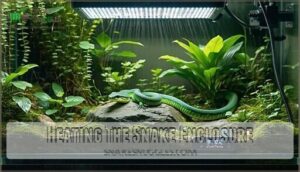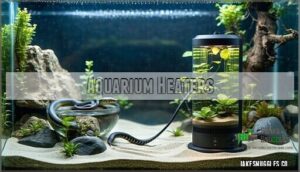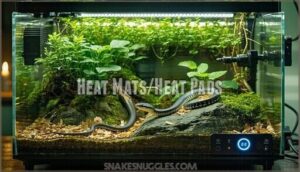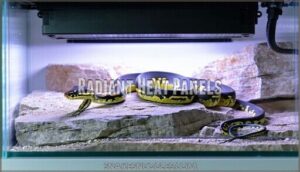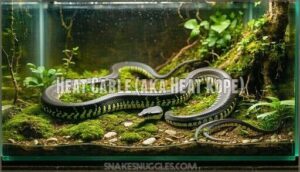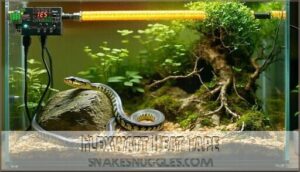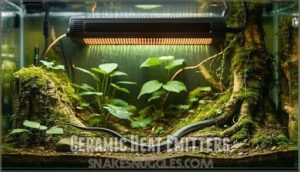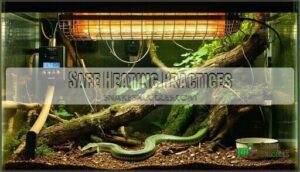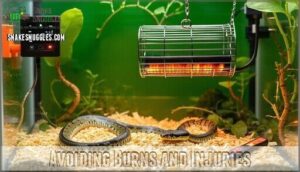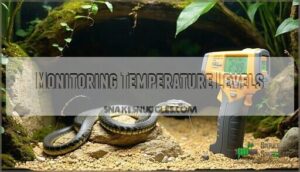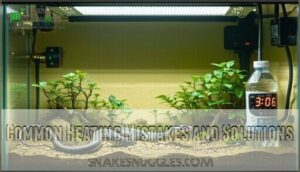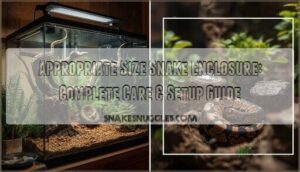This site is supported by our readers. We may earn a commission, at no cost to you, if you purchase through links.
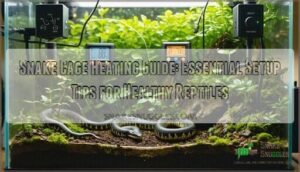
They rely on external warmth to digest food, stay active, and maintain their immune system. You’ll need to create a thermal gradient with temperatures ranging from 75-85°F on the cool side and 88-95°F for basking spots.
Heat mats covering one-third of the enclosure floor work well for ground-dwelling species, while ceramic heat emitters provide ambient warmth without light.
Always use thermostats to prevent dangerous overheating and digital thermometers to monitor both sides of the enclosure. The secret lies in mimicking nature’s temperature variations perfectly.
Table Of Contents
- Key Takeaways
- Choosing The Right Snake
- Setting Up a Snake Enclosure
- Heating The Snake Enclosure
- Heating Options for Snakes
- Safe Heating Practices for Snakes
- Heating and Lighting Cycles for Snakes
- Common Heating Mistakes and Solutions
- Energy Efficiency and Cost-Effective Heating
- Advanced Heating Options for Snakes
- Troubleshooting Heating Issues in Snakes
- Frequently Asked Questions (FAQs)
- How do I heat my snake enclosure?
- How does a snake heat a cage?
- How do you heat a snake’s habitat?
- How do you heat a reptile cage?
- Is it safe to heat a snake’s enclosure?
- Can you put a heat panel in a reptile cage?
- How to properly heat a snake enclosure?
- What is the best heating option for a snake enclosure?
- What temperature should a snake cage be?
- What should my snakes heating pad be at?
- Conclusion
Key Takeaways
- You’ll need external heat sources since snakes can’t regulate their own body temperature – use heat mats, radiant heat panels, or ceramic heat emitters to create proper thermal gradients between 75-95°F
- Always use thermostats with your heating equipment to prevent dangerous overheating and burns – unregulated heat sources can exceed safe temperatures and seriously harm your snake
- Create a thermal gradient in your enclosure with cool areas (75-85°F) and warm basking spots (88-95°F) so your snake can move between temperature zones for proper thermoregulation
- Monitor temperatures daily with digital thermometers and place heat sources to cover only one-third of the enclosure floor – this mimics natural conditions and prevents your entire habitat from becoming too hot
Choosing The Right Snake
Before you can set up proper heating, you’ll need to choose the right snake species for your experience level and living situation.
Starting with beginner-friendly species like corn snakes, ball pythons, or Australian pythons will make your heating setup much easier to manage, as they are generally considered beginner-friendly.
Popular Snakes for Beginners
Starting your reptile journey? You’ll want docile snake species that won’t bite the hand that feeds them.
These low-maintenance snakes make perfect first pets:
- Corn snakes: Hardy with stunning patterns and easy handling techniques
- Ball pythons: Calm giants that rarely show aggression
- Children’s pythons: Compact size meets gentle nature
Each species has unique temperament differences, but all three excel at beginner snake care.
Your snake enclosure and reptile heating setup will determine their comfort, so choose wisely before committing.
Spotted Pythons Characteristics
Spotted pythons are perfect starter snakes with their docile nature and complete venom absence.
These Australian beauties reach a manageable size range of 1-1.4 meters, displaying stunning olive-brown bodies with dark spotted patterns.
Their calm temperament makes snake cage setup stress-free, while proper reptile heating and snake temperature gradient guarantee their 15-20 year lifespan.
You’ll love their gentle personality.
Childrens Pythons Characteristics
Children’s pythons offer beginner suitability with their compact size limitations of 3-4 feet, making snake enclosure management simple.
These childrens pythons display calm temperament traits and easy handling ease, perfect for new owners.
Their adaptable nature means basic enclosure needs work well – just verify proper reptile heating in your snake cage.
You’ll appreciate their forgiving personality and straightforward snake heating requirements, making them ideal starter snakes.
Stimsons Pythons Characteristics
After exploring Children’s pythons, let’s meet another Australian gem that’ll surprise you with its adaptability. Stimson’s pythons are nature’s shape-shifters, perfectly suited for snake heating enthusiasts who want something unique.
These remarkable reptiles showcase incredible Polymorphic Traits that make each individual special:
- Arid Adaptations allow them to thrive in Australia’s harshest desert conditions
- Grow to a manageable 3 feet, making Enclosure Needs straightforward
- Temperament Details reveal docile, beginner-friendly personalities
- Can fast for extended periods without health concerns
- Conservation Status remains stable across their native range
Your snake cage won’t need complex heating methods since these hardy pythons handle temperature fluctuations well. Their desert origins mean they’re comfortable with standard reptile heating setups, making them perfect starter snakes for new keepers.
Setting Up a Snake Enclosure
You’ll need to create the perfect environment before bringing your new snake home.
Setting up a proper enclosure involves choosing the right terrarium size, selecting appropriate substrate, adding enrichment features, controlling temperatures, and providing proper lighting.
To keep your reptile healthy and happy, all these elements must be carefully considered and implemented.
Terrarium Selection and Size
Choosing your snake’s terrarium is like finding the perfect apartment – size matters. Your snake enclosure needs room for your pet to stretch out completely.
The enclosure size should match at least one-quarter of your snake’s adult snake length in width, with length equal to their full adult size. A standard 4x2x2 terrarium works well for beginners, but larger snakes need bigger spaces like 5x2x2 reptile enclosures.
Material choices include glass or PVC for durability. Don’t forget security considerations – door locks prevent escape artists.
Enclosure dimensions should allow spatial enrichment opportunities. Remember, your snake cage setup is their entire world, so make it spacious and secure.
Substrate Options for Snakes
When selecting substrate for your snake enclosure, you’re building the foundation of their comfort. Aspen bedding works great for dry-loving species, while coco coir mixed with orchid bark provides excellent humidity control for moisture-loving snakes.
Consider dig boxes filled with substrate for burrowing species. Proper bedding is essential, and you can buy aspen bedding for your snake’s enclosure.
Your substrate choice impacts your snake cage setup success:
- Aspen bedding – absorbs odors naturally and allows tunneling
- Coco coir – retains moisture perfectly for tropical species
- Orchid bark – creates natural drainage in your reptile habitat heating system
- Mixed substrates – balance humidity and comfort for ideal enclosure setup
Providing Enrichment for Snakes
Your snake’s enclosure setup isn’t complete without proper Hides and Security. Place multiple hideouts throughout your snake cage—one on each temperature zone.
Climbing Opportunities like branches satisfy arboreal instincts, while Dig Boxes filled with substrate encourage natural burrowing behaviors.
Add Sensory Enrichment through texture variety and Novelty Items like artificial plants. A proper temperature gradient is also essential for thermoregulation.
This environmental complexity supports snake health by reducing stress and promoting natural behaviors essential for snake care.
Temperature Requirements for Snakes
With enrichment sorted, your snake needs proper snake cage heating to survive.
These cold-blooded reptiles can’t regulate body temperature internally, making thermal gradient creation your top priority.
Species preferences vary, but most thrive between 75-85°F with basking behavior spots reaching 88-95°F.
Research your snake’s specific needs – altitude effects and seasonal variation influence natural temperature ranges, affecting optimal snake temperature requirements for healthy controlling snake temperature year-round.
Lighting Options for Snakes
Illuminate your snake’s world with proper lighting that goes beyond basic visibility.
Quality lighting affects behavior, health, and natural rhythms in ways you mightn’t expect.
Your lighting toolkit should include:
- UVB bulb for vitamin D synthesis and bone health
- Basking bulbs creating essential warm zones
- LED options like JungleDawn LED Bar for energy efficiency
- T5 fixture supporting proper UVB benefits
Natural light cycles matter more than you’d think.
Install lighting timers to automate 12-hour day/night patterns.
This mimics wild conditions and keeps your snake’s internal clock running smoothly.
Heat lamp snake setups work great with lighting cycles, creating realistic temperature drops at night.
Your reptile’s body will thank you for this attention to detail.
Heating The Snake Enclosure
Proper heating transforms your snake enclosure from a simple container into a thriving habitat that keeps your reptile healthy and active.
You’ll need to understand thermal gradients, temperature ranges, and heating methods to create the perfect environment that mimics your snake’s natural habitat, utilizing complete concepts to ensure the best results.
Why Do Snakes Need Heat
Your snake can’t make its own body heat like you do. These cold-blooded creatures depend on external warmth for digestion aid and metabolism boost.
Your snake depends on you for heat – it’s their life source, not a luxury
Without proper temperature control, your pet struggles to break down food or move around normally. Heat directly affects their behavioral impact too – think of it as your snake’s daily fuel.
Proper thermoregulation needs keep them active and healthy. Reptile heating isn’t optional; it’s what powers your snake’s entire system for maximum health promotion.
Temperatures for Ball Pythons
Understanding temperature needs is fundamental for snake cage heating success. Ball pythons require precise temperature control to stay healthy and active.
Your setup needs an ideal gradient from cool side (78-80°F) to warm side (88-92°F). Night temperatures shouldn’t drop below 75°F, while hatchling temps run slightly higher at 92-94°F on the basking spot.
Key temperature zones for your ball python:
- Cool side: 78-80°F for comfortable resting
- Warm side: 88-92°F for proper digestion
- Basking spot: 90-92°F peak heating zone
- Nighttime: Never below 75°F minimum
Remember, humidity impact affects how temperatures feel to your snake. Use a quality snake heating pad or reptile heat mat with reliable temperature control systems.
The Thermal Gradient
Getting your ball python’s temperatures right is just the start. Now you’ll create a thermal gradient – your snake’s personal temperature highway that lets them move between warm and cool zones for perfect thermoregulation behavior.
Think of it as snake cage heating that mimics nature’s blueprint:
- Warm basking spot – where your python soaks up heat for digestion
- Cool retreat area – their chill zone when temperatures get too toasty
- Gradient zones between – smooth temperature control shifts throughout the enclosure
This thermogradient setup promotes natural thermoregulation behavior while reducing stress. Different species show gradient variation in their preferences, so measuring gradients regularly confirms your heat sources create the ideal temperature control your specific python needs.
Methods for Heating The Cage
You’ve got several snake enclosure heat options to choose from. Each method works differently, so pick what fits your setup and budget best.
| Heating Method | Best For |
|---|---|
| Heat mats | Small snakes, belly heat |
| Radiant heat panels | Overhead warming, energy efficiency |
| Ceramic heat emitters | Night heating without light |
| Heat cables | Multiple cages, custom layouts |
Heat mat placement goes under one-third of your cage floor.
RHP benefits include even heat distribution and long lifespan. CHE alternatives like heat projectors work great too.
Cable customization lets you snake heating elements around odd-shaped enclosures.
Remember tape regulation – always use thermostats with any heat source for safety.
Heating Options for Snakes
You’ll find several proven heating options that keep your snake comfortable and healthy throughout the year.
Each method has unique benefits, so choosing the right one depends on your snake species, enclosure setup, and personal preferences.
Aquarium Heaters
Many snake keepers wonder if aquarium heaters work for snake cage heating. Unfortunately, submersible heaters aren’t suitable for most snake enclosures since they need full water immersion to function safely.
Here’s why aquarium heaters fall short for snake enclosure heat:
- Glass thickness makes them fragile in dry terrarium environments
- Wattage calculation becomes ineffective without proper water depth
- Temperature stability suffers when heaters can’t cycle properly
- External filters and water systems aren’t needed for most snakes
- Safety risks increase dramatically when used outside water
These heaters work great for aquatic reptiles but create more problems than solutions in typical snake enclosures.
Snakes, being ectothermic, require specific setups to maintain proper temperature control for ideal health.
Heat Mats/Heat Pads
Heat mats, those trusty under tank heaters, deliver reliable belly heat that snakes crave. These UTH reptile devices work best for smaller species needing localized warmth.
Place your heat pad under one-third of the enclosure to create proper thermal gradients. Always pair heat mats with thermostats—unregulated units can exceed dangerous temperatures and cause burns.
Many retailers offer various snake heat mats for different enclosure sizes.
| Wattage | Tank Size | Coverage Area |
|---|---|---|
| 4-8W | 5-10 gallons | 6"x8" |
| 8-16W | 10-20 gallons | 8"x12" |
| 16-24W | 20-40 gallons | 11"x17" |
| 28-32W | 40-55 gallons | 12"x18" |
| 40W+ | 55+ gallons | 14"x20" |
Radiant Heat Panels
Radiant heat panels mount to your enclosure ceiling and emit infrared warmth that penetrates deep into your snake’s body.
This PVC compatibility makes them perfect for modern setups. Choose RHP wattage between 40-80W for most snake enclosure heating needs.
RHP placement on top creates natural basking spots while RHP safety features prevent burns. Pair with a thermostat reptile system for precise control.
With proper reptile heating, these panels last 10+ years (RHP lifespan), making them cost-effective for serious snake care enthusiasts.
Heat Cable (aka Heat Rope)
Flexible heating solutions don’t get much better than heat cable for your snake enclosure. This bendable heating method wraps around branches or snakes along enclosure floors, creating customizable warm zones. You’ll love how it delivers consistent belly heat while maintaining temperature consistency across multiple setups.
- Cable Installation: Route underneath tanks in zigzag patterns covering 30-40% of floor space
- Temperature Consistency: Provides steady 15-50 watts per meter for gradual, reliable heating
- Cage Placement: Perfect for racks, custom builds, and breeding operations requiring flexible heat sources
- Safety Concerns: Always use thermostats and avoid overlapping cables to prevent dangerous overheating
- Species Suitability: Ideal for pythons, boas, and geckos needing substrate warmth rather than ambient heat
Flexwatt Heat Tape
Flexwatt Heat Tape transforms your reptile heating solutions with customizable lengths you cut yourself.
This snake vivarium heating option delivers steady warmth across its surface, perfect for creating thermal gradients.
Heat Tape Installation requires proper thermostat pairing for Heat Regulation.
Tape Safety means placing it outside the enclosure where your snake can’t touch it.
Tape Maintenance involves checking connections regularly for your snake cage heating guide success.
Ceramic Heat Emitters
Ceramic heat emitters work like tiny furnaces, providing steady warmth without disrupting your snake’s sleep cycle.
These ceramic heaters offer reliable thermal control for your snake vivarium heating needs.
Key benefits of ceramic emitters:
- Provide heat output up to 20°F above room temperature
- Last 3-5 years with proper use
- Emit no light, perfect for nighttime heating
- Create effective thermal gradients when positioned correctly
- Require protective guards for emitter safety
Always use thermostats with these heating elements to prevent overheating.
Safe Heating Practices for Snakes
Proper heating safety protects both you and your snake from serious injuries or house fires.
You’ll need the right equipment and knowledge to create a safe thermal environment that keeps your reptile healthy without risking burns or electrical hazards, which is crucial for proper heating safety.
Safe Heating Practices
Safe heating practices aren’t just smart—they’re lifesavers for your snake. Temperature control starts with a quality thermostat that prevents dangerous overheating.
Place heat sources outside the enclosure whenever possible to reduce burn risks. When using ceramic heat emitters or radiant heat panels inside, install protective guards around them. This creates safe snake heating without sacrificing warmth.
Here are five thermal safety essentials:
- Monitor constantly – Digital thermometers provide real-time temperature readings
- Create distance – Position branches at varying heights from heat sources
- Guard electrical connections – Keep all wiring away from moisture and snake contact
- Test regularly – Check your thermostat calibration monthly for accurate temperature control
- Plan backup heating – Have secondary heat sources ready for equipment failures
Remember: electrical safety and burn prevention go hand-in-hand with proper temperature monitoring.
Avoiding Burns and Injuries
In regards to burn prevention, your snake’s safety depends on smart heat source placement and proper monitoring.
Heat mats placed inside enclosures cause 60% of documented reptile burns because snakes make direct contact with hot surfaces.
Always position heat sources outside the enclosure or use protective barriers.
Temperature monitoring with digital thermostats prevents 85% of heating accidents.
Faulty or missing thermostats create dangerous heat surges that exceed safe limits.
Your thermostat should control every heat source, while infrared thermometers help spot-check for hot spots.
Thermal injury often results from unprotected heating elements.
Ceramic heat emitters reach over 300°C on their surface, so install protective cages around any internal bulbs.
Safe snake heating means creating proper thermal gradients without exposing your pet to direct heat contact.
Heat Lamps
Heat Mats
Heat Cable
Regular skin inspections help catch heat safety issues early, ensuring ideal snake welfare through proper injury avoidance practices.
Preventing Electrical Fires
Beyond burns, electrical hazards can turn your snake’s cozy home into a dangerous situation. Fire Safety starts with smart planning and regular maintenance.
Your Heat Source equipment needs regular attention. Faulty wiring doesn’t give warnings before sparking problems. Check connections monthly and replace damaged cords immediately.
To guarantee proper heating, consider radiant heat panels, which are a safe and efficient option.
Here are five Electrical Checks every snake owner should master:
- Inspect heating cables and power cords for cracks or exposed wires
- Test thermostats and digital thermometers for proper function
- Verify heat mats and ceramic heat emitters have secure connections
- Use Circuit Protection with surge protectors rated for your equipment
- Practice proper Wire Management by keeping cords away from water and heat.
Never daisy-chain multiple heating devices on one outlet. Your electrical system can only handle so much before it protests with sparks.
Keep a fire extinguisher nearby and know how to use it. Remember, a working smoke detector beats dealing with crispy consequences later.
Providing a Thermal Gradient
Creating a thermal gradient in your snake enclosure mimics nature’s temperature zones perfectly. Think of it as building temperature neighborhoods where your snake can choose their ideal comfort spot.
Here’s how to establish proper Gradient Importance:
- Position heat sources at one end only
- Create temperature zones from warm to cool
- Allow natural thermoregulation behavior throughout
This habitat mimicry lets your snake move between areas for digestion, rest, or activity. Proper temperature control supports healthy thermoregulation behavior essential for snake wellness.
Monitoring Temperature Levels
Your snake’s health depends on accurate temperature tracking throughout its snake enclosure.
Use digital thermometers with probes at both basking and cool spots to monitor your thermogradient.
Infrared guns provide instant surface readings for quick gradient checks.
Regular thermostat calibration guarantees reliable temperature control.
Check temps daily to catch fluctuations early – consistent temperatures keep your snake comfortable and stress-free in its home.
Heating and Lighting Cycles for Snakes
You’ll need to establish proper day and night cycles to keep your snake healthy and mimic their natural habitat.
Setting up automated lighting and heating timers makes this process easier and guarantees your pet gets consistent temperature and light patterns without you having to manually adjust everything twice a day, ensuring a healthy environment.
Day/Night Cycles
Most snakes thrive with consistent photoperiod regulation that mimics their natural environment.
You’ll want to provide 12 hours of light followed by 12 hours of darkness to support healthy circadian rhythms.
This lighting cycle directly influences your snake’s behavioral impacts, including feeding patterns and activity levels.
Use timer automation to maintain consistent heat sources and lighting cycles without constant monitoring.
Here’s what proper day/night cycles deliver for your snake enclosure:
- Better appetite – Your snake will eat more regularly with consistent routines
- Reduced stress – Predictable patterns create a calming environment
- Natural behaviors – Proper cycles encourage normal hunting and resting patterns
- Healthier breeding cycles – Consistent photoperiods support reproductive health
Your thermostat and heating system work together with lighting to create the perfect environment your snake needs.
Seasonal Cycles
While daily day/night cycles keep your snake on track, seasonal cycles reveal their natural programming.
Temperature drops of 5-8°F during winter months trigger brumation periods in many species, while spring warming kickstarts breeding triggers and improved feeding adjustments.
These activity changes also regulate shedding patterns—your reptile heating guide should include gradual seasonal adjustments.
Smart temperature control and heating options make these transitions automatic, supporting your snake’s biological rhythms year-round.
A vital aspect involves understanding temperature gradient creation to allow snakes to thermoregulate effectively.
Lighting and Heating Timers
Timers take the guesswork out of your snake’s daily routine. You won’t need to remember when to flip switches or worry about forgetting your pet’s needs during busy days.
Modern digital timers offer incredible benefits for your snake enclosure:
- Automated Schedules maintain consistent cycles without daily intervention
- Precise Control guarantees exact lighting and heating durations
- Energy Savings reduce electricity costs through optimized operation
- Reptile Health improves through reliable environmental patterns
These devices work seamlessly with your thermostat and heating options, creating stable conditions your snake craves. Digital thermometers paired with timers give you complete environmental oversight.
Automating Lighting and Heating Cycles
Embracing Smart Thermostats transforms your snake enclosure from basic to brilliant.
These automated systems eliminate guesswork while maintaining perfect heating options around the clock.
Digital thermometer readings sync with lighting timers to create seamless day-night cycles.
Modern thermostat technology adjusts temperatures automatically, mimicking seasonal simulation patterns your snake would experience in nature.
Energy savings pile up when systems only run when needed.
Lighting cycles coordinate with heating schedules, reducing your workload dramatically.
These systems monitor your snake enclosure continuously, sending alerts if temperatures drift.
You’ll sleep better knowing your scaly friend enjoys consistent comfort year-round.
Smart Thermostat
Humidity Control
Remote Monitoring
Multi-Device Control
Common Heating Mistakes and Solutions
Even experienced snake keepers make heating mistakes that can harm their pets’ health. You’ll learn how to spot and fix the most common heating problems that plague snake enclosures.
Insufficient Heating
Cold temperatures can turn your snake cage into a reptilian nightmare.
When temperatures plummet, your snake’s world becomes a slow-motion survival struggle
Low temperatures create a domino effect of health problems that’ll have you scrambling for solutions.
When your snake’s world gets too chilly, you’ll notice telltale stress signs like sluggish movement and refusing meals.
Digestion problems become common since snakes need warmth to process food properly.
Shedding issues also arise, leading to stuck skin patches.
Their weak immunity makes them vulnerable to infections.
Poor heat sources are usually the culprit.
Maybe your heating equipment isn’t powerful enough, or you’re not monitoring temperatures consistently.
Drafty spots can sabotage even the best heating setup.
The fix? Invest in quality heating equipment and check temperatures daily.
Use reliable thermostats for temperature control and position heat sources strategically.
Your troubleshooting efforts will pay off when your snake returns to normal behavior and appetite, and you avoid a reptilian nightmare with proper temperature control.
Overheating
While insufficient heating creates problems, the opposite extreme poses equally serious risks.
Overheating transforms your snake’s home into a dangerous furnace that can quickly become life-threatening.
Watch for these warning signs that signal your reptile care needs immediate attention:
- Frantic pacing around the enclosure seeking cooler spots
- Open-mouth breathing or excessive gaping behavior
- Lethargy combined with elevated body temperature
- Skin discoloration or visible stress responses
When thermostat malfunction strikes, your heating options can become deadly weapons.
Poor enclosure ventilation amplifies the problem, trapping hot air like an oven.
Each heat source requires careful monitoring since species sensitivity varies dramatically between different snakes.
Emergency response means turning off all heating immediately and providing fresh air circulation.
Troubleshooting starts with checking your thermostat’s calibration and ensuring proper snake care protocols are followed consistently.
Incorrect Temperature Gradients
Creating a proper thermal gradient isn’t optional—it’s your snake’s lifeline.
Without gradual temperature zones, thermoregulation failure kicks in fast. You’ll spot behavioral changes like constant hiding or restless movement.
Digestive issues follow when your snake can’t find the right temps for processing food. Poor temperature control creates stress indicators throughout your enclosure.
Smart heating methods with reliable thermostats fix gradient impact problems quickly.
Inadequate Humidity
Poor humidity can make your snake’s life miserable.
You’ll spot the warning signs quickly: stuck shed pieces clinging to their skin, wheezing sounds during breathing, or your snake spending excessive time soaking in their water bowl.
Key humidity problems include:
- Shedding Problems – Incomplete sheds create infection risks and discomfort
- Respiratory Infections – Dry air irritates delicate lung tissues
- Dehydration Signs – Sunken eyes and wrinkled skin indicate moisture loss
Smart reptile care means monitoring humidity levels with digital gauges.
Substrate moisture from cypress mulch or coconut fiber helps maintain proper levels naturally.
Solutions to Common Heating Mistakes
Quick fixes save the day when your best snake heater goes rogue.
Thermostat Malfunction? Replace immediately—your snake’s life depends on it. Incorrect Wattage causing Gradient Imbalance? Switch to appropriate wattage for your enclosure size.
Inaccurate Readings from cheap thermometers? Invest in quality digital ones. For Burn Prevention, always use guards around heat source for snakes.
When troubleshooting heating options, check connections first—loose wires cause headaches. Remember: good snake care means being proactive, not reactive.
Energy Efficiency and Cost-Effective Heating
You’ll want to keep your heating costs under control without compromising your snake’s health and comfort. Smart heating choices can slash your electricity bills while maintaining perfect temperatures year-round.
Energy-Efficient Heating Options
Smart snake heating doesn’t have to break the bank. You’ve tackled common mistakes—now let’s explore cost-effective heating that keeps your snake comfortable without shocking your electric bill.
Modern heating tech offers impressive energy savings while maintaining perfect temperatures.
- Low-Wattage Heaters like ceramic heat emitters deliver consistent warmth using minimal power
- Smart Thermostats automatically adjust heating output, cutting energy waste by up to 35%
- LED Lighting provides necessary illumination at under 10 watts per enclosure
- Insulation Benefits from reflective materials can improve heat retention by 25%
Reducing Energy Consumption
Your electric bill doesn’t have to snake its way out of control. Simple tweaks can cut heating costs substantially while keeping your reptile comfortable.
Timer Automation controls day/night cycles, saving 15-25% on energy. Smart Thermostats prevent unnecessary heating spikes. LED Lighting uses 75% less power than old-school bulbs. Insulation Methods like foam boards retain heat better. Efficient Equipment like radiant heat panels beats energy-hungry heat lamps every time.
These cost-effective heating strategies keep both your snake and wallet happy.
Cost-Effective Heating Solutions
You don’t need to spend a fortune to keep your snake warm and happy.
Smart shoppers know where to find budget heat solutions that work just as well as expensive options.
Cost-effective heating options include:
- Used equipment from reptile forums and classifieds
- DIY solutions like ceramic heat emitters with basic thermostats
- Insulation tips such as covering three enclosure sides with foam boards
- Energy savings through programmable timers and efficient heat sources.
These heating options deliver reliable warmth without the premium price tag, proving cost-effective heating doesn’t mean cutting corners on your snake’s comfort.
Calculating Energy Needs
Most snake keepers don’t realize their energy efficiency choices can slash monthly bills by 40%.
Wattage calculation starts with your enclosure size—a 4x2x2 setup typically needs 50-75 watts for proper heat sources.
Factor in heat loss through glass or screen tops, which can double your needs.
Poor insulation impact means higher running costs, so consider PVC enclosures over glass tanks.
Your thermostat efficiency matters too.
Quality models prevent energy waste by cycling precisely, while cheap ones fluctuate wildly.
Calculate actual usage: a 75-watt heat pad running 50% of the time costs about $3 monthly.
Cost-effective heating means choosing radiant heat panels over ceramic emitters—they’re 30% more efficient.
Smart heating options like programmable thermostats optimize energy use automatically, keeping your snake happy and your wallet intact.
Advanced Heating Options for Snakes
You’ve mastered the basics of snake heating, but advanced systems can transform your setup from functional to exceptional.
Smart thermostats, automated controls, and high-end equipment offer precision that keeps your snake healthier while making your life easier, with advanced systems being key to this improvement.
Smart Thermostats and Heating Systems
Modern thermostat technology puts you in complete control of your snake’s environment with unmatched precision and convenience.
Advanced heating systems with Automated Control eliminate guesswork through programmable temperature schedules and Safety Features like emergency shutoffs.
Remote Monitoring via smartphone apps lets you check temperatures anywhere, while built-in digital thermometer readings guarantee accuracy.
One key aspect is understanding snake enclosure heating for ideal health.
Here’s what gets snake keepers excited about upgrading:
- Never worry about power outages – backup alerts keep you informed
- Sleep soundly knowing your snake’s temperature stays perfect automatically
- Save money monthly through intelligent Energy Savings algorithms
- Feel confident with professional-grade Breeding Automation capabilities
These energy efficiency champions adapt to room temperature changes seamlessly, making advanced heating options both practical and affordable for serious reptile enthusiasts.
Advanced Lighting and Heating Cycles
Smart thermostats revolutionize how you control your snake’s environment. These advanced heating options create precise seasonal simulation cycles that mirror natural habitats.
Your deep heat projector or radiant heat panel can gradually adjust temperatures throughout the year, supporting breeding setups for sensitive species. Imagine programming winter cooling periods followed by spring warming – it’s like giving your snake a nature documentary experience!
Ceramic heat emitters work perfectly with automated systems, while heating projector bulbs provide excellent daylight simulation.
| Cycle Type | Temperature Range | Duration |
|---|---|---|
| Spring Warming | 75-82°F | 8-10 weeks |
| Summer Peak | 80-85°F | 12-16 weeks |
| Fall Cooling | 78-80°F | 6-8 weeks |
| Winter Rest | 70-75°F | 16-18 weeks |
Automated Temperature and Humidity Control
Technology can transform your snake’s habitat into a precision-controlled environment.
Smart thermostats with humidity sensors offer remote monitoring through smartphone apps, automatically adjusting heating and temperature control based on real-time data.
Advanced systems feature automated misting and system integration that coordinates your thermostat, digital thermometer, and humidity control seamlessly.
These gadgets maintain perfect conditions 24/7, sending alerts when parameters drift outside safe ranges.
High-End Heating Options for Snakes
Premium snake heating systems elevate your reptile keeping to professional levels.
Smart Thermostats like the Herpstat provide Precise Control over temperature fluctuations, while Automated Systems manage complex heating schedules.
- Deep Heat Projector units from Arcadia Reptile deliver penetrating warmth that mimics natural sunlight
- Radiant Heat Panel technology offers silent, efficient heating perfect for Sensitive Species
- Ceramic Heat Emitter arrays create customizable thermal zones ideal for Breeding Projects
These systems shine when standard heating falls short.
Troubleshooting Heating Issues in Snakes
Even the best heating setups can hit snags, leaving you scratching your head when temperatures won’t cooperate.
You’ll learn how to spot common problems like cold spots, overheating, and thermostat failures, plus get practical fixes that’ll have your snake’s habitat running smoothly again.
Heating Issues and Solutions
Heating problems can turn your snake’s home into a temperature nightmare. When your thermostat malfunctions or power outages strike, don’t panic.
Uneven heating often stems from poor ceramic heat emitter placement or faulty radiant heat panel positioning. Your basking spot should hit target temps while burrow temperature stays cooler.
| Problem | Quick Fix |
|---|---|
| Thermostat Malfunction | Replace batteries, check connections |
| Uneven Heating | Reposition heat source, add second unit |
| Power Outages | Use backup heat packs, insulate enclosure |
| Cold Basking Spot | Increase wattage, move heat source closer |
Smart troubleshooting starts with checking your heating equipment connections first.
Troubleshooting Temperature Issues
Temperature problems can drive any snake keeper crazy! When your reptile care hits a snag, start with the basics.
Inaccurate thermometers and thermostat malfunctions top the troubleshooting list, but don’t forget enclosure placement affects heating too.
- Check your equipment – Replace faulty thermometers and test thermostat accuracy
- Verify power sources – Power outages can reset your temperature control systems
- Match species needs – Different snakes require specific heating requirements for proper snake enclosure function
Advanced Troubleshooting Techniques
When basic fixes don’t work, you’ll need detective skills. Thermostat malfunctions often hide behind faulty sensors or gradient problems. Watch your snake’s reptile behavior – sluggish movement signals heating issues.
Equipment failure during power outages requires backup plans. Smart troubleshooting means checking connections, calibrating digital thermometers, and testing thermostats regularly.
| Problem | Advanced Solution |
|---|---|
| Inconsistent heating | Relocate sensors, check airflow |
| Equipment keeps failing | Install surge protectors, backup systems |
| Temperature swings | Upgrade to proportional temperature control |
Your heating system’s reliability depends on proactive maintenance and strategic problem-solving.
Frequently Asked Questions (FAQs)
How do I heat my snake enclosure?
Like a warm blanket wrapping around your snake, you’ll need heat mats, radiant panels, or ceramic emitters with thermostats. Create temperature gradients of 75-85°F, ensuring proper belly heat coverage.
How does a snake heat a cage?
Snakes don’t actually heat cages themselves.
You’ll need external heat sources like heat mats, radiant panels, or ceramic emitters to create the warm temperatures your snake requires for proper digestion and health.
How do you heat a snake’s habitat?
You’ll need external heat sources since snakes can’t regulate body temperature internally. Use heat mats, radiant heat panels, or ceramic heat emitters with thermostats to create proper thermal gradients safely.
How do you heat a reptile cage?
Following Benjamin Franklin’s wisdom that fire makes a good servant but a bad master, you’ll heat your reptile cage using controlled heat sources like mats, panels, or bulbs.
Install thermostats to regulate temperature and create thermal gradients for proper thermoregulation.
Is it safe to heat a snake’s enclosure?
Yes, it’s completely safe to heat your snake’s enclosure when you use proper equipment.
You’ll need thermostats to prevent overheating, digital thermometers for monitoring, and appropriate heating methods like heat mats or radiant panels, which are essential for maintaining a safe environment, utilizing thermostats.
Can you put a heat panel in a reptile cage?
You can safely install radiant heat panels in reptile cages.
They’re actually one of the best heating methods available, as RHPs emit infrared heat, work perfectly with thermostats, and won’t burn your snake.
How to properly heat a snake enclosure?
Snake owners spend over 90% of their setup budget on heating mistakes.
You’ll need a thermal gradient using heat mats, radiant panels, or ceramic emitters with thermostats.
Place heat sources on one side, creating 75-85°F zones for proper thermoregulation.
What is the best heating option for a snake enclosure?
Radiant heat panels offer the best heating solution for your snake’s enclosure. They’re safe, efficient, and create natural thermal gradients without burning risks, unlike heat mats or bulbs.
What temperature should a snake cage be?
Think of your snake’s cage like Goldilocks’ porridge—it needs to be just right.
You’ll want a thermal gradient from 70-85°F, with cool sides around 75-80°F and warm basking spots reaching 80-85°F for proper thermoregulation.
What should my snakes heating pad be at?
Your heating pad should reach 85-90°F on the warm side. Always use a thermostat to control temperature and prevent burns. Check with an infrared thermometer regularly for accuracy.
Conclusion
Money talks, but proper heating speaks volumes for your snake’s health and happiness.
Following this snake cage heating guide guarantees your reptile thrives in captivity.
Remember that consistent temperatures, proper gradients, and quality equipment aren’t luxuries—they’re necessities.
Your snake depends on you to recreate nature’s thermal balance.
With the right setup, regular monitoring, and safety measures in place, you’ll provide the foundation for a long, healthy life for your scaly companion.
- https://apexreptile.com/blogs/apex-reptile-blog/complete-guide-to-heating-and-lighting-your-pvc-reptile-enclosure
- https://cornsnake.net/pages/heating
- https://www.neherpetoculture.com/vivariumenviro_control
- https://talis-us.com/blogs/news/optimal-temperature-ranges-for-corn-snakes
- https://www.sensorpush.com/articles/temperature-and-humidity-monitoring-for-pet-reptiles-and-amphibians


